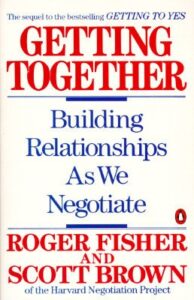Getting Together: Building Relationships as We Negotiate: Part 3
Couples sometimes struggle with communication. The inability to communicate leads to all sorts of misunderstandings, failures to resolve problems, and cycles that build up to create significant dissatisfaction with the relationship. Fisher and Brown, of the Harvard Negotiation Project, present some fundamental elements of communicating and problem solving in their book Getting Together: Building Relationships as We Negotiate. This book is the sequel to the bestseller Getting to Yes. Although not writing from a therapy background, their work on communication is consistent with what we share with our clients at Fuller Life. This the third post in a series on Getting Together.
The first post introduced six elements of a good working relationship. The overriding theme in each element is: “Do only those things that are both good for the relationship and good for us, whether or not they reciprocate” (38). These six elements are based on a commitment to be unconditionally constructive. Now we will look a bit closer at the third of the six.
3. Communication: Always consult before deciding – and listen.
Poor communication can take its toll on any relationship. Improving communication is a necessary requirement of a good working relationship. Three factors that might prevent effective communication are:
1. When partners assume there is no need to communicate.
2. When partners only send one type of communication – speaking. What’s missing? Listening. If both people are “transmitting” and neither is receiving, how much communication is actually taking place? Who is responsible to listen?
3. When we send mixed messages. It is important for our actions to match our words. We need to do our best to be consistent from one day to the next.
Fisher and Brown suggest three ways of strengthening the relationship through communication.
- ACBD – Always consult before deciding. Consultation helps balance emotion and reason. It promotes better understanding and two-way communication. It also aids reliability. Consultation establishes acceptance in the other person – our partner’s opinion and input is valuable.
- Listen actively. Many of us have a tendency to “get in our heads” when we are not speaking. We think about what we are going to say next. Put that on hold. Make an intention to listen, not just hear, the other person. Listen with empathy. Try to understand the issue through the other person’s point of view. Inquire. Ask questions. When taking the part of the speaker, be clear and succinct in order to aid the other person’s attempt to actively listen.
- Plan the communication process to minimize mixed messages. Clarify the purpose in advance. Be honest about mixed feelings. Plan the setting because some conversations need to be in private. Consider timing and setting to help control emotion. For example, it is almost never a good time to have an emotion-laden conversation when either partner is tired or hungry.
- Another element that I sometimes share with my clients is the importance of checking for understanding. Though it might seem stereotypical of a therapist, the phrase “So what I hear you saying is…” is tremendously useful. It is a shortcut through many possible misunderstandings. It acknowledges that we sometimes make errors in decoding what we hear as well as communicates a desire to understand. Taking the time to say “Let me see if I heard you right…” is well worth the effort. Although, speaking comes fairly naturally to most of us, listening is something that takes intentional attention and practice.
If you think could benefit from a collaborative partnership to improve your relationship with your partner, a family member, friend, co-worker, or employee, send us a note through our website or call us at one of the numbers listed. We are happy to listen.
Resident Therapist at Fuller Life Family Therapy Institute










